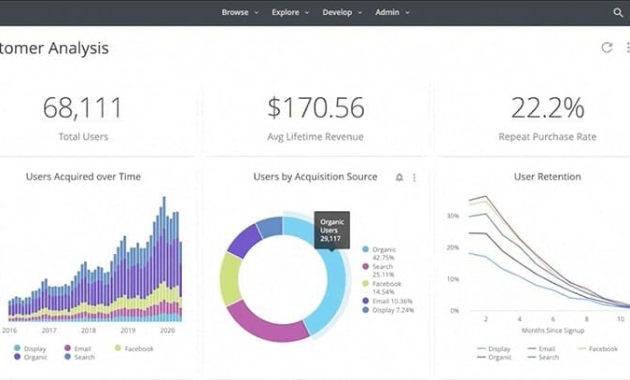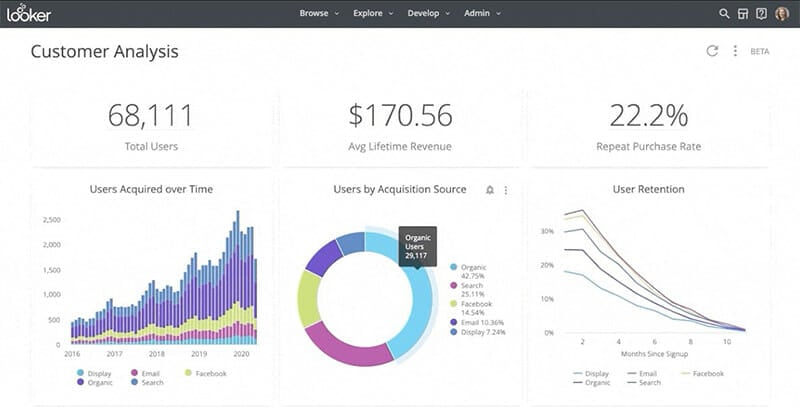
Unlocking Insights: Exploring Self-Service Business Intelligence Software with Predictive Tools
In today’s data-driven landscape, businesses are constantly seeking ways to extract meaningful insights from their vast datasets. The ability to analyze data, identify trends, and make informed decisions is no longer a luxury but a necessity for survival and growth. This is where self-service business intelligence (BI) software with predictive tools comes into play, empowering users to take control of their data and unlock its hidden potential. This article will delve into the world of self-service BI, exploring its benefits, functionalities, and the transformative impact of predictive analytics.
The Rise of Self-Service BI
Traditional BI solutions often required specialized technical expertise and significant IT involvement. This created bottlenecks, delaying access to critical information and hindering agility. Self-service business intelligence software has emerged as a solution to these challenges, democratizing data access and analysis. It empowers business users with the tools they need to explore, visualize, and analyze data independently, without relying on IT departments for every request.
The core principle of self-service BI is user empowerment. These platforms typically offer intuitive interfaces, drag-and-drop functionality, and pre-built templates, making it easy for users with varying levels of technical expertise to create reports, dashboards, and visualizations. This enables faster decision-making, improved collaboration, and a more data-driven culture within organizations.
Key Features of Self-Service BI Software
Self-service business intelligence software typically offers a range of features designed to facilitate data exploration and analysis. Some of the most common features include:
- Data Connectivity: The ability to connect to a wide variety of data sources, including databases, spreadsheets, cloud services, and social media platforms.
- Data Preparation: Tools for cleaning, transforming, and preparing data for analysis, such as data cleansing, data blending, and data wrangling.
- Data Visualization: A comprehensive set of visualization options, including charts, graphs, maps, and dashboards, to help users communicate data insights effectively.
- Reporting and Dashboards: Features for creating interactive reports and dashboards that provide a real-time view of key performance indicators (KPIs) and other important metrics.
- Data Discovery: Capabilities for exploring data, identifying trends, and uncovering hidden patterns.
- Collaboration: Features that allow users to share insights, collaborate on reports, and work together on data analysis projects.
The Predictive Power: Predictive Tools in Self-Service BI
The integration of predictive tools is a significant advancement in self-service business intelligence software. Predictive analytics leverages statistical techniques, machine learning algorithms, and data mining to forecast future trends, identify potential risks, and optimize business outcomes. This allows businesses to move beyond reactive analysis and proactively anticipate future events.
Predictive tools typically found in self-service business intelligence software include:
- Forecasting: Predicting future values of key metrics based on historical data, such as sales, revenue, or customer demand.
- Regression Analysis: Identifying relationships between variables and predicting the impact of changes in one variable on another.
- Classification: Categorizing data into predefined groups based on specific criteria, such as customer segmentation or fraud detection.
- Clustering: Grouping similar data points together to identify patterns and segments within the data.
- Anomaly Detection: Identifying unusual or unexpected data points that may indicate potential problems or opportunities.
Benefits of Using Self-Service BI with Predictive Tools
Implementing self-service business intelligence software with predictive tools offers a multitude of benefits for businesses of all sizes. Some of the most significant advantages include:
- Improved Decision-Making: By providing access to real-time data and predictive insights, self-service BI empowers business users to make more informed and data-driven decisions.
- Increased Efficiency: Automating data analysis and reporting processes frees up valuable time and resources, allowing employees to focus on more strategic initiatives.
- Enhanced Agility: The ability to quickly adapt to changing market conditions and customer needs is crucial for success. Self-service BI enables businesses to respond rapidly to new information and opportunities.
- Reduced Costs: By empowering business users to perform their own data analysis, self-service BI can reduce the need for expensive IT consultants and specialized data analysts.
- Competitive Advantage: By leveraging predictive analytics, businesses can gain a deeper understanding of their customers, markets, and competitors, enabling them to make better strategic decisions and gain a competitive edge.
- Data Democratization: Providing access to data for all employees fosters a data-driven culture. This helps in better understanding, more informed decision making, and innovation.
Choosing the Right Self-Service BI Software
Selecting the right self-service business intelligence software with predictive tools requires careful consideration of various factors. Some key considerations include:
- Ease of Use: The software should have an intuitive interface and drag-and-drop functionality, making it easy for users with varying levels of technical expertise to use.
- Data Connectivity: Ensure the software can connect to all of your relevant data sources.
- Data Visualization Capabilities: The software should offer a wide range of visualization options to communicate insights effectively.
- Predictive Analytics Features: Evaluate the predictive tools offered by the software and ensure they meet your specific business needs.
- Scalability: The software should be able to handle your current data volume and scale to accommodate future growth.
- Security: Ensure the software offers robust security features to protect your sensitive data.
- Cost: Consider the total cost of ownership, including software licensing fees, implementation costs, and ongoing maintenance.
- Support and Training: Ensure the vendor provides adequate support and training to help you get the most out of the software.
Real-World Applications
Self-service business intelligence software with predictive tools is being used across a wide range of industries and applications. Here are a few examples:
- Retail: Retailers use predictive analytics to forecast sales, optimize inventory levels, personalize marketing campaigns, and identify potential fraud.
- Healthcare: Healthcare providers use predictive analytics to identify patients at risk, predict hospital readmissions, and optimize resource allocation.
- Finance: Financial institutions use predictive analytics to detect fraud, assess credit risk, and personalize customer offers.
- Manufacturing: Manufacturers use predictive analytics to predict equipment failures, optimize production processes, and improve supply chain management.
- Marketing: Marketers use predictive analytics to identify high-potential leads, personalize customer experiences, and optimize marketing campaigns.
These are just a few examples of the many ways that self-service business intelligence software with predictive tools is transforming businesses. The ability to extract actionable insights from data is becoming increasingly important for organizations that want to thrive in today’s competitive environment.
The Future of Self-Service BI
The future of self-service business intelligence software is bright. As data volumes continue to grow and the need for data-driven decision-making increases, the demand for these tools will only continue to rise. We can expect to see several key trends shaping the future of self-service BI:
- Increased Automation: Automation will play a larger role in data preparation, analysis, and reporting, making it easier for users to extract insights.
- Enhanced Artificial Intelligence (AI) and Machine Learning (ML): AI and ML will be integrated more deeply into self-service BI platforms, providing more advanced predictive capabilities and automating data analysis tasks.
- Improved Collaboration: Collaboration features will become more sophisticated, enabling users to share insights, collaborate on reports, and work together on data analysis projects more effectively.
- Greater Accessibility: Self-service BI tools will become more accessible to a wider range of users, including those with limited technical expertise.
- Data Governance and Security: Stronger emphasis on data governance and security to ensure data privacy and compliance.
Conclusion
Self-service business intelligence software with predictive tools is a powerful solution for businesses seeking to unlock the value of their data. By empowering business users with the tools they need to explore, analyze, and predict future trends, these platforms enable faster decision-making, improved efficiency, and a competitive advantage. As the data landscape continues to evolve, the importance of self-service BI will only continue to grow. Businesses that embrace these tools will be well-positioned to succeed in the data-driven future. Investing in the right self-service BI solution is an investment in your business’s future.
[See also: Data Visualization Best Practices]
[See also: The Impact of AI in Business Intelligence]
[See also: Choosing the Right BI Tool for Your Business]

